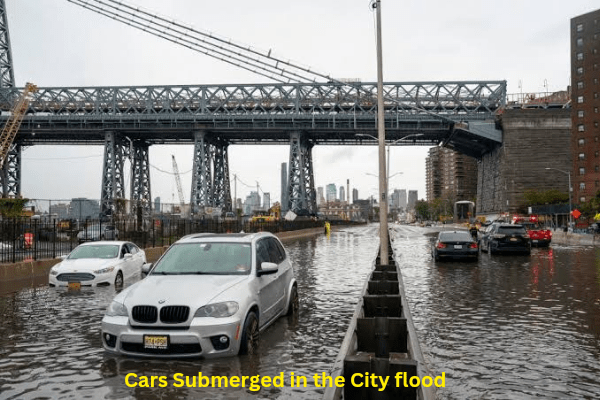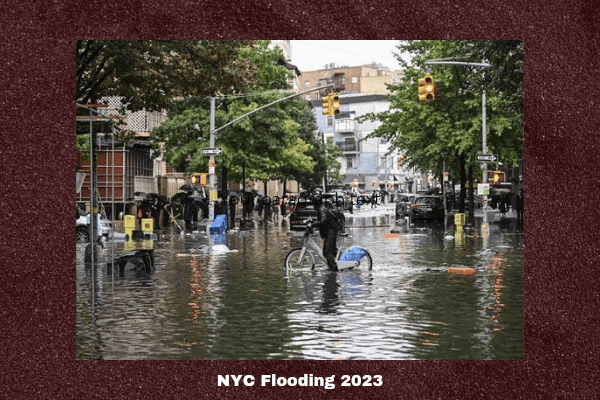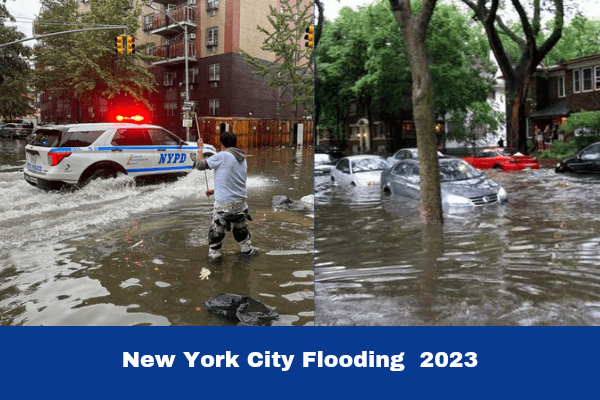As it deals with the fallout of a severe storm that caused disastrous Nyc flooding, the city that never sleeps, has come to a complete halt. The city has been flooded by severe rains, paralysing the transport infrastructure and trapping many citizens in the flooded mess. A state of emergency has been declared. We shall examine the specifics of the emergency situation, its effects on New York City, and the steps taken to lessen the issue in this article.
Table of Contents
The Deluge: Unprecedented Rainfall Swamps NYC
As a persistent downpour inundated the metropolis, New York metropolis found itself in the throes of a meteorological nightmare. According to reports, certain sections experienced rapid rainfall of up to 8 inches (20 cm), which severely taxed the city’s infrastructure. A sluggish storm system that lashed the city with its wrath caused this incredible amount of rain.
Governor Kathy Hochul tweeted, “This is a dangerous, life-threatening storm,” which went viral across the state. She then proclaimed a state of emergency for New York City, Long Island, and the Hudson Valley. Given the seriousness of the situation, she sternly warned the locals to be safe and to avoid attempting to drive on flooded roadways.
Impact on Transportation: A City Paralyzed
As Nyc flooding tooks hold strong transit network, which is renowned for its effectiveness, came to an abrupt halt. As a result of the flood, numerous subway lines were suspended totally, and stations were shut down. Significant delays for commuters resulted from the fact that the Metro North commuter rail service was also affected.
When asked about the severity of the issue, Mayor Eric Adams said that “some of our subways are flooded, and it is extremely difficult to move around the city.” As the waves surged, he observed that many people had been saved from automobiles and basement flats.
Also have a look at Tupac Shakur Murder: Decades-Long Mystery Unraveled 2023


Flooding at LaGuardia Airport forced the temporary closure of Terminal A, disrupting flying travelers. Before leaving for the airport, passengers were encouraged to verify with their airlines. Numerous road closures were also announced by the New York Police Department, and the National Guard was called in to help with crisis management.
Record-Breaking Rainfall: Wettest September Since 1882
According to the National Weather Service, September 2023 was the wettest September in New York City since 1882 because of the unprecedented amount of rain that was measured. The city has experienced nearly 14 inches of rain only this month, underscoring how unusual this weather phenomenon is.
Infrastructure Struggles: Sewage System Overwhelmed
As a result of the storm’s strength being greater than the city’s ability to handle the rainfall, New York City’s infrastructure was put to a great deal of stress. According to Chief Climate Officer of New York, Rohit Aggarwal, the city’s sewage system was only built to manage 1.75 inches of rain per hour, much less than what the storm produced. Due to the over 2.5 inches of rain that fell in just one hour, portions of Brooklyn suffered the effects of this insufficient infrastructure the most severely.
Dramatic images of rescue operations were sparked by the flooding of the streets and subways. In Mamaroneck, a suburb to the north of the city, emergency personnel used inflatable rafts to free people who were stuck inside flooded structures.


Economic Toll: Nyc Flooding Damage and Financial Fallout
Beyond the immediate risks that the floods present, there is also the impending economic cost. Both citizens and business owners are coping with the fallout. A Gowanus resident named Kelly Hayes calculated the cost of the destruction caused by floods to her bar and kitchen at between $25,000 and $30,000. Many of the disaster’s victims will face considerable financial hardships during the recovery process.
Government Response: Coordinated Efforts Amid Crisis
Several government departments have quickly and effectively coordinated their responses to this emergency situation:
– New York State Division of Homeland Security and Emergency Services:
To keep track of storm emergencies in immediate form and support local governments in need, the department launched the State Emergency Operations Center. Westchester County has sent out flood rescue teams to help with flood emergency response.
– Metropolitan Transportation Authority (MTA):
In order to restore safe and dependable service on the subways, Metro-North Railroad, and Long Island Rail Road, MTA personnel worked nonstop to pump water out of the track area. Customers were advised to sign up for alerts and check for real-time service changes to stay updated.
– Port Authority:
The Port Authority kept an eye on the weather and established speed limits on the roads and bridges leading to the crossings. In order to get the most recent information on delays and cancellations, passengers were encouraged to contact the airlines and carriers directly.
– New York State Department of Transportation:
The State Department of Transportation kept up its around-the-clock efforts to combat Nyc flooding and guarantee traffic safety. Before the evening rush hour, traffic signal repair teams were sent out to perform a variety of maintenance tasks.
– Thruway Authority:
Staff from the Westchester County Thruway Authority quickly reacted to Nyc flooding and helped other communities affected by ramp closures.
– Department of Public Service: Energy sector infrastructure damages are being reduced and repaired by utility companies, and the Department of Public Service is closely watching utility response and restoration operations.
– Office of Parks, Recreation, and Historic Preservation: Swift water rescue teams were sent to the area, and park staff members kept a watchful eye on the weather. Visitors to the park were urged to check for the most recent updates on park hours and closures.
– New York State Police: In the impacted areas, State Police sent out more officers and Nyc flooding rescue squads that were outfitted with airboats and inflatable boats. Specialized vehicles were ready to respond right away.
Latest Exciting Showdown Unveiled: 2023 Ryder Cup Tees Off!
Flash Flooding Safety Tips: A Reminder for All
It is vital for citizens and guests to heed safety recommendations due to the consequences of Nyc flooding:
– You should never try to drive on a flooded road. Find a different route and turn around.
– If water is fast rising around your car, get out of it right away.
– Never underestimate the force of rushing water; merely two feet of it can float a car and provide a serious threat.
Conclusion
The emergency declaration in city emphasizes how severe the Nyc flooding was brought the city to its knees. The tenacity of New Yorkers and the well-coordinated reaction of government agencies will be essential in bringing normalcy to the city that never sleeps as cleanup and recovery work get underway. The city that never backs down is preparing for future catastrophic weather events as the floodwaters recede and the focus turns to rebuilding homes, businesses, and infrastructure.
FAQs
1. What caused the flash flooding in New York City?
A slow-moving storm system that released torrential rainfall and overwhelmed the city’s drainage and sewage systems was what led to the Nyc flooding.
2. How much rainfall did New York City receive during this event?
The city of New York experienced its wettest September since 1882, with some places receiving up to 8 inches (20 cm) of rain in a matter of hours.
3. What is the economic impact of the flooding in New York City?
The flooding has had a huge negative economic impact on many businesses and residents, who must pay expensive repair and recovery expenditures. For instance, one local estimated the cost of $25,000 to $30,000 in flood damage to her bar and kitchen.
4. What safety tips should residents and visitors follow during flash flooding?
- Never try to drive on a road that is flooded.
- If your vehicle is engulfed in quickly rising water, abandon it right away and find an other path.
- Never undervalue the force of rushing water; merely two feet of it can float a car and provide a serious threat.


[…] Have a look at NYC Flooding ,Declares State of Emergency […]